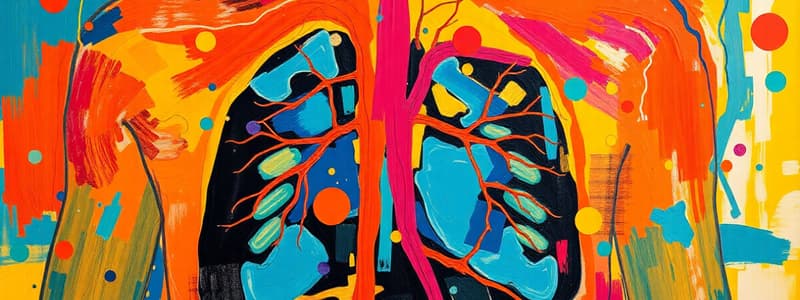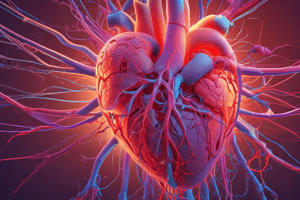Podcast
Questions and Answers
Which component of the autonomic nervous system is most significantly involved in the regulation of circulation?
Which component of the autonomic nervous system is most significantly involved in the regulation of circulation?
- Parasympathetic Nervous System
- Enteric Nervous System
- Sympathetic Nervous System (correct)
- Somatic Nervous System
How does venous constriction, mediated by the sympathetic nervous system, contribute to the regulation of circulation?
How does venous constriction, mediated by the sympathetic nervous system, contribute to the regulation of circulation?
- By decreasing preload on the heart
- By increasing preload to the heart (correct)
- By increasing venous volume
- By decreasing afterload on the heart
What physiological change occurs when a spinal anesthetic inhibits the sympathetic nervous system's baseline activity?
What physiological change occurs when a spinal anesthetic inhibits the sympathetic nervous system's baseline activity?
- Increased heart rate
- Dramatic decrease in blood pressure (correct)
- Decreased vascular resistance
- Increased blood pressure
Epinephrine from the adrenal medulla impacts the circulatory system in which of the following ways?
Epinephrine from the adrenal medulla impacts the circulatory system in which of the following ways?
Which combination of factors most effectively contributes to a rapid increase in arterial pressure when the body is under stress?
Which combination of factors most effectively contributes to a rapid increase in arterial pressure when the body is under stress?
How do baroreceptors respond to a sudden increase in arterial pressure?
How do baroreceptors respond to a sudden increase in arterial pressure?
Why are baroreceptors considered a 'pressure buffer system'?
Why are baroreceptors considered a 'pressure buffer system'?
What is the primary stimulus that activates chemoreceptors in the arterial system?
What is the primary stimulus that activates chemoreceptors in the arterial system?
How do the low-pressure stretch receptors in the atria and pulmonary arteries respond to increased atrial stretch?
How do the low-pressure stretch receptors in the atria and pulmonary arteries respond to increased atrial stretch?
What is the Bainbridge reflex?
What is the Bainbridge reflex?
In the context of the CNS ischemic response, what triggers the body to elevate systemic arterial pressure?
In the context of the CNS ischemic response, what triggers the body to elevate systemic arterial pressure?
Why is the CNS ischemic response considered an emergency pressure control mechanism rather than a normal regulatory process?
Why is the CNS ischemic response considered an emergency pressure control mechanism rather than a normal regulatory process?
What is the Cushing reaction?
What is the Cushing reaction?
Which of the following is NOT a factor that causes respiratoy variation in arterial pressure?
Which of the following is NOT a factor that causes respiratoy variation in arterial pressure?
What is the implication of respiratory variation frequently coming up in an ICU?
What is the implication of respiratory variation frequently coming up in an ICU?
Which nerve carries parasympathetic innervation to the heart, allowing for a decrease in heart rate?
Which nerve carries parasympathetic innervation to the heart, allowing for a decrease in heart rate?
What is the effect of sympathetic innervation on arteries and arterioles?
What is the effect of sympathetic innervation on arteries and arterioles?
How does decreased afferent arterial resistance in the kidneys affect fluid loss?
How does decreased afferent arterial resistance in the kidneys affect fluid loss?
What happens to blood pressure upon standing, and how do baroreceptors counteract this change?
What happens to blood pressure upon standing, and how do baroreceptors counteract this change?
Aside from dilation of arterioles, what other effect does atrial stretch have on the kidneys to increase fluid loss?
Aside from dilation of arterioles, what other effect does atrial stretch have on the kidneys to increase fluid loss?
Flashcards
Autonomic Nervous System
Autonomic Nervous System
Part of the nervous system that controls involuntary actions, comprising the sympathetic and parasympathetic systems.
Sympathetic Nervous System
Sympathetic Nervous System
The division of the autonomic nervous system that prepares the body for 'fight or flight' responses; most important for regulating circulation.
Parasympathetic Innervation of Heart
Parasympathetic Innervation of Heart
Decreases heart rate via the vagus nerve, with minor effects on contractility; plays a minor role in vascular function.
Sympathetic Vasoconstriction
Sympathetic Vasoconstriction
Signup and view all the flashcards
Vasomotor Center
Vasomotor Center
Signup and view all the flashcards
Nervous Control Effects
Nervous Control Effects
Signup and view all the flashcards
Baroreceptors
Baroreceptors
Signup and view all the flashcards
Baroreceptor Stimulation Effects
Baroreceptor Stimulation Effects
Signup and view all the flashcards
Baroreceptor Response
Baroreceptor Response
Signup and view all the flashcards
Baroreceptor Function
Baroreceptor Function
Signup and view all the flashcards
Chemoreceptors
Chemoreceptors
Signup and view all the flashcards
Chemoreceptor Reflex
Chemoreceptor Reflex
Signup and view all the flashcards
Bainbridge Reflex
Bainbridge Reflex
Signup and view all the flashcards
CNS Ischemic Response
CNS Ischemic Response
Signup and view all the flashcards
Cushing Reaction
Cushing Reaction
Signup and view all the flashcards
Study Notes
Nervous Regulation of Circulation
- The autonomic nervous system regulates circulation via the sympathetic and parasympathetic systems.
- The sympathetic system is the more important of the two in regulating circulation.
- Sympathetic fibers exit the spinal cord through thoracic and lumbar spinal nerves, passing through the sympathetic chain to specific nerves or peripheral spinal nerves that supply the vasculature.
- Sympathetic innervation of arteries and arterioles increases resistance and decreases flow.
- Venous innervation and constriction decreases venous volume, which in turn increases preload.
- Parasympathetic innervation of the heart, via the vagus nerve, decreases heart rate, with minor effects on contractility.
- The parasympathetic nervous system plays a minor role in regulating vascular function.
Sympathetic Vasoconstriction
- Nerve fibers throughout the body continuously transmit impulses at a slow rate, maintaining partial constriction, which is evident during spinal anesthesia.
- Spinal anesthesia leads to a dramatic decrease in blood pressure, due to inhibiting the sympathetic system.
- The vasomotor center in the brain controls heart rate, contraction strength, and vascular tone.
- Sympathetic impulses are transmitted to both blood vessels and the adrenal medulla.
- The adrenal medulla secretes epinephrine and norepinephrine into the blood, which act directly on blood vessels.
- Nervous control rapidly increases arterial pressure through arterial constriction, venous constriction, and enhanced cardiac pumping.
- Arterial constriction increases peripheral resistance, thus increasing arterial pressure.
- Venous constriction displaces blood to the heart, increasing stretch and cardiac output.
- Enhanced cardiac pumping is achieved by elevating heart rate and contractility, greatly affecting cardiac output (cardiac output = stroke volume x heart rate).
Baroreceptors
- Baroreceptors, or stretch receptors, are located in the walls of large systemic arteries.
- Rising pressure causes stretch, which sends inhibitory signals to the CNS, decreasing autonomic nervous system stimulation.
- Aortic baroreceptors and carotid sinus baroreceptors (located prior to bifurcation) are key types.
- Baroreceptors respond rapidly to changing pressure, with impulses increasing as pressure increases, but they adapt to long-term stationary pressure.
- Rapid blood pressure changes induce activity, while slow adjustments may cause minimal response.
- Baroreceptor stimulation causes dilation of veins and arterioles, as well as decreased heart rate and contractility.
- Baroreceptors help maintain pressure upon standing by responding to decreased blood pressure with elevated blood pressure, and are considered a pressure buffer system.
- The effect of baroreceptors on long-term blood pressure regulation is controversial, potentially having a minimal effect through interaction with the kidneys.
- Baroreceptor stimulation during carotid endarterectomy can cause massive blood pressure swings.
Chemoreceptors
- Chemoreceptors are sensitive to low oxygen or elevated carbon dioxide and hydrogen levels.
- Diminished blood flow decreases oxygen while increasing CO2 and hydrogen levels.
- Chemoreceptors excite the vasomotor center.
- This chemoreceptor reflex is more important at lower blood pressures, as it's not powerful enough when arterial pressure is above 80.
Low Pressure Stress Receptors
- Atria and pulmonary arteries have low-pressure stress receptors in their walls, similar to baroreceptors.
- Atrial stretch reduces renal sympathetic nerve activity, causing dilation of arterioles and decreased tubular reabsorption.
- Stimulation is sent to the hypothalamus to decrease antidiuretic hormone secretion (ADH).
- Decreased afferent arterial resistance increases fluid filtration into the renal tubules.
- This, combined with decreased ADH, increases fluid loss by the kidneys.
- Atrial natriuretic peptide is released, causing further excretion of sodium and water.
- The Bainbridge reflex increases heart rate when blood volume is increased.
CNS Ischemic Response & Cushing Reaction
- When brain blood flow is insufficient to remove carbon dioxide from the brainstem vasomotor center, systemic pressure rises.
- Known as the CNS ischemic response, this can elevate arterial pressure to 250 for up to ten minutes.
- Sympathetic stimulation can be so great that peripheral vessels become occluded.
- This response is not a normal regulatory mechanism, but an emergency pressure control system for severe hypotension.
- The Cushing reaction results from increased CSF pressure in the cranial vault.
- Increased CSF pressure causes arterial compensation and closure.
- The Cushing reaction increases arterial pressure higher than CSF pressure for blood flow to continue.
Respiratory Effects on Arterial Pressure
- Arterial pressure rises and falls in a wave-like manner with respiration, caused by three factors:
- Breathing signals spill over to the vasomotor center in the medulla.
- Negative intrathoracic pressure causes blood vessels to expand, reducing venous blood return.
- Atrial stretch receptors are influenced by intrathoracic pressure changes.
- Respiratory variation is significant in anesthesia, particularly with positive pressure ventilation, which alters intrathoracic pressure.
Studying That Suits You
Use AI to generate personalized quizzes and flashcards to suit your learning preferences.




